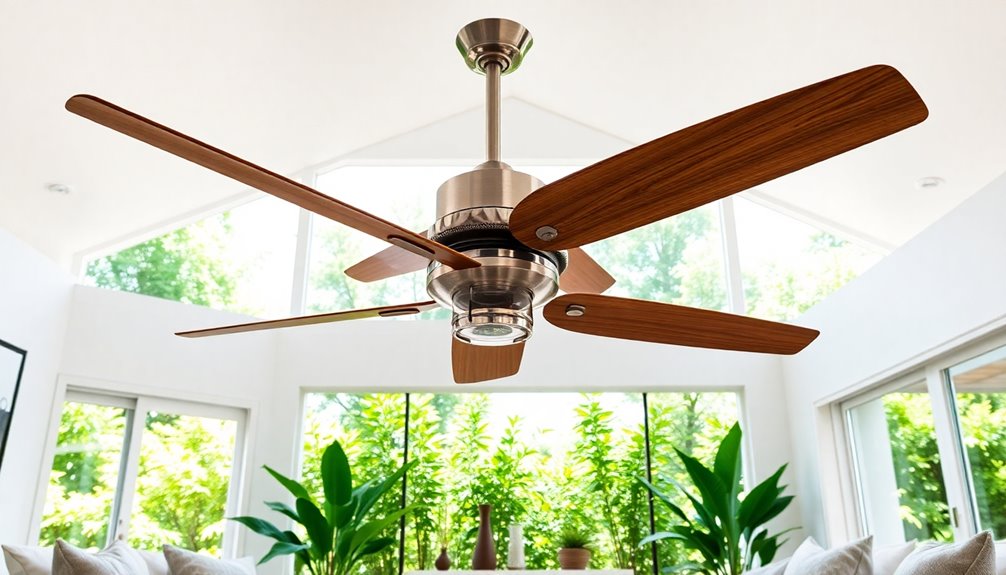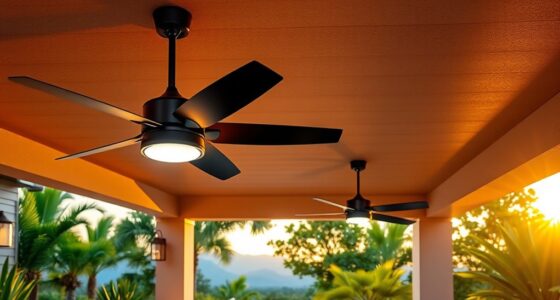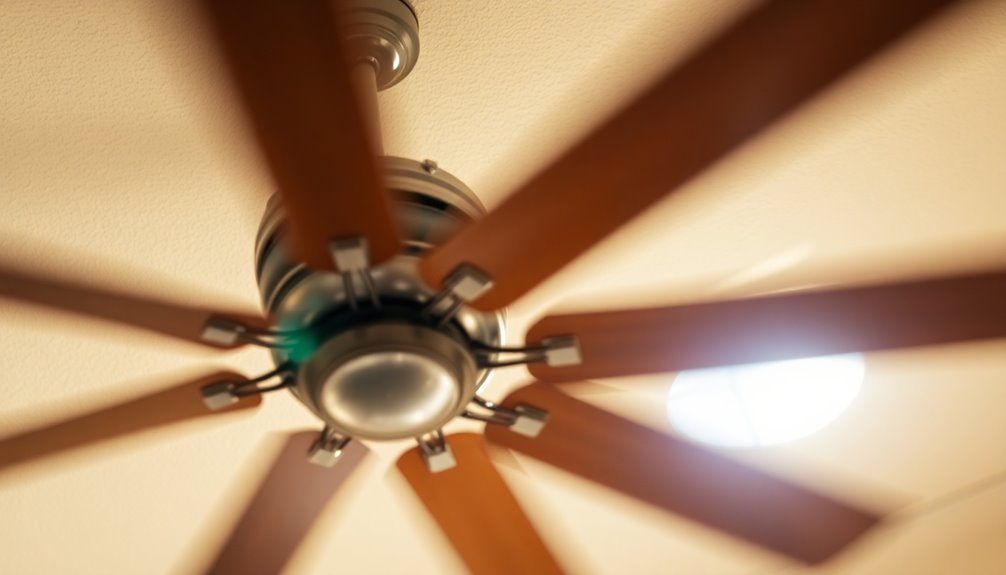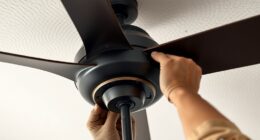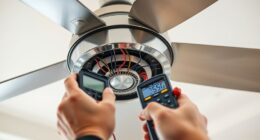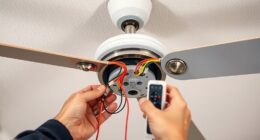Fan blade pitch is the angle of the fan blades relative to the ground. It’s like the slant of a ramp. The steeper the angle, the more air the blade can push. Most ceiling fans have a blade pitch between 10 and 15 degrees. The pitch angle affects how much air the fan moves, how efficient it is, and how well it performs overall.
Let’s explore how fan blade pitch affects your fan’s performance, efficiency, and comfort in your home.
Key Points: Fan Blade Pitch
- Optimal blade pitch: 12-15 degrees
- Steeper pitch moves more air
- Affects fan efficiency and noise
- Important for cooling and heating
- Typical range: 10-15 degrees for ceiling fans
- Interacts with other fan design elements
- Crucial factor in fan selection
1. What is Fan Blade Pitch?
Fan blade pitch is the angle of the fan blades relative to the ground. It’s like the slant of a ramp. The steeper the angle, the more air the blade can push. Most ceiling fans have a blade pitch between 10 and 15 degrees, but this range can vary depending on the specific fan design and intended use. The pitch angle plays a significant role in determining the fan’s airflow capacity, energy efficiency, and overall performance.
A steeper blade pitch doesn’t always mean better performance. It’s all about finding the right balance for your space. Choosing the right ceiling fan involves considering blade pitch along with other factors such as room size, ceiling height, and desired airflow. The optimal pitch can vary depending on the fan’s intended use, whether it’s for homes, offices, or factories.
2. The Science Behind Blade Pitch
When a fan blade spins, it pushes air. The angle of the blade determines how much air it moves and how fast. A higher pitch moves more air but requires more energy from the motor. A lower pitch is easier on the motor but might not move as much air. This relationship is based on principles of fluid dynamics and aerodynamics, where the blade pitch affects the lift and drag forces acting on the fan blades as they rotate.
It’s like paddling a boat. A steep paddle angle moves more water but takes more effort. A shallow angle is easier but might not move you as fast. Energy-efficient ceiling fans find the sweet spot between airflow and power use, often using advanced blade designs and materials to optimize this balance.
3. Optimal Blade Pitch for Ceiling Fans
Most experts agree that the ideal blade pitch for ceiling fans is between 12 and 15 degrees. This range offers the best balance of airflow and energy efficiency. Fans with pitches in this range can move plenty of air without putting too much strain on the motor. However, this “ideal” range can vary depending on factors such as blade length, number of blades, and how the fan will be used.
Remember, blade pitch is just one part of the equation. The type of ceiling fan motor also plays a big role in overall performance. A high-quality motor can effectively handle a steeper blade pitch, while a less powerful motor might struggle with the same angle.
4. Impact on Airflow
Blade pitch directly affects how much air your fan moves. This is measured in Cubic Feet per Minute (CFM). A higher pitch generally means higher CFM, but it’s not a simple “more is better” situation. The relationship between blade pitch and airflow is not straight, with less improvement as the pitch gets steeper beyond a certain point. Things like air resistance and turbulence come into play at higher pitch angles, potentially reducing efficiency.
A fan with a 15-degree pitch might move more air than one with a 12-degree pitch, but it might also use more energy and create more noise. It’s about finding the right balance for your needs. This balance can depend on factors such as room size, ceiling height, and how much cooling you need.
5. Energy Efficiency and Blade Pitch
The relationship between blade pitch and energy efficiency is complex. A steeper pitch moves more air but requires more power from the motor. This can lead to higher energy consumption. The efficiency of a fan is often measured in terms of CFM per watt, which takes into account both the airflow produced and the energy consumed. Finding the optimal pitch for energy efficiency involves balancing these factors to achieve the highest CFM per watt ratio.
On the other hand, a fan with the right pitch for its motor and blade design can be very efficient. It’s all about matching the blade pitch to the fan’s other components. ENERGY STAR certified ceiling fans are a great example of this balance. These fans are tested to make sure they save energy while still working well.
6. Noise Levels and Blade Pitch
Blade pitch can affect how noisy your fan is. A steeper pitch can create more turbulence, which leads to more noise. However, a well-designed fan with the right pitch for its speed and motor can run quietly even at high speeds. The relationship between blade pitch and noise is influenced by factors such as blade shape, material, and the overall aerodynamic design of the fan.
If you’re looking for a quiet fan, don’t just focus on blade pitch. Look at the overall design and quality of the fan. The quietest ceiling fans balance blade pitch with other noise-reducing features such as advanced motor technology, vibration-dampening components, and aerodynamic blade designs.
7. Seasonal Performance: Summer vs Winter
Did you know that blade pitch affects your fan’s performance in different seasons? In summer, you want your fan to push air straight down for a cooling effect. A steeper pitch is good for this as it can create a stronger downdraft, making the room feel cooler. To maximize this cooling effect, the ideal summer pitch might be slightly higher than the year-round average.
In winter, many people reverse their fans to create an updraft. This helps circulate warm air without creating a chilly breeze. A moderate pitch works well for both summer and winter use. Learn more about using your ceiling fan year-round to stay comfortable and save energy in all seasons.
8. Interaction with Other Fan Components
Blade pitch doesn’t work alone. It interacts with other parts of the fan, like the motor power and the number of blades. A powerful motor can handle a steeper pitch, while a fan with more blades might need a lower pitch to balance the load. The relationship between these components is crucial for optimal performance. For example, a fan with fewer blades might benefit from a steeper pitch to move the same amount of air as a fan with more blades at a shallower pitch.
The fan’s housing design also plays a role. A well-designed housing can help direct airflow, making the most of the blade pitch. Understanding ceiling fan parts can help you see how everything works together to create an efficient and effective cooling system.
9. Customization and Adjustable Pitch
Some high-end fans come with adjustable blade pitches. This lets you fine-tune your fan’s performance for different seasons or room setups. While cool, these fans are often more expensive and complex. The ability to adjust blade pitch can be particularly useful in spaces with changing needs, such as multi-purpose rooms or areas with big temperature changes between seasons.
For most homes, a well-chosen fixed-pitch fan is plenty. If you’re interested in customization, look into smart ceiling fans that offer control over speed and direction. These fans often come with advanced features like temperature and humidity sensors, allowing them to automatically adjust their operation for optimal comfort and efficiency.
10. Choosing the Right Blade Pitch for Your Space
When picking a fan, consider your room size and ceiling height. A large room might benefit from a fan with a steeper pitch to move more air. A small room might do better with a gentler pitch for a more subtle airflow. The height of your ceiling also plays a role – higher ceilings may require fans with steeper pitches to effectively circulate air throughout the entire space.
Your climate matters too. In very hot areas, a fan with a steeper pitch might be worth the extra energy use. In milder climates, a moderate pitch could be perfect. Check out our guide on choosing the right ceiling fan size for more tips on matching your fan to your space and climate needs.
| Pitch Angle | Airflow | Energy Efficiency | Noise Level |
|---|---|---|---|
| 8-10° | Low | High | Low |
| 12-14° | High | Medium | Medium |
| 16-18° | Medium | Low | High |
11. Future Trends in Fan Blade Design
Fan technology is always improving. New blade shapes and materials are being developed to increase airflow while reducing energy use. Some fans now use airfoil-shaped blades, like airplane wings, to move air more efficiently. These advanced designs often use ideas from airplane engineering to make the blade work better at different angles and speeds. Manufacturers are also exploring the use of new materials that allow for more complex blade shapes while staying strong and light.
Smart fans that adjust their pitch automatically based on room conditions are also coming soon. These fans might use sensors to detect temperature, humidity, and if people are in the room, then adjust their pitch and speed for the best comfort and efficiency. Keep an eye on ceiling fan technology trends to see what’s coming next in fan blade design and smart home features.
12. Maintenance and Blade Pitch
Over time, fan blades can get out of alignment, affecting their pitch. Regular cleaning and checking can help maintain your fan’s performance. If you notice your fan isn’t moving as much air as it used to, it might be time for a tune-up. Dust buildup can also affect how the blade moves through the air, potentially making it less efficient even if the pitch is still correct. Regular cleaning not only makes the fan look better but also keeps it working its best.
Some fans allow for small pitch adjustments during cleaning. Always follow the manufacturer’s instructions, or consider professional ceiling fan installation and maintenance for best results. Professional technicians can use special tools to measure and adjust blade pitch accurately, making sure your fan works as efficiently as possible.
Conclusion
Understanding fan blade pitch helps you choose the right ceiling fan for your needs. While a pitch between 12 and 15 degrees is often ideal, the best choice depends on your specific situation. Consider your room size, climate, and personal preferences when selecting a fan. Remember that blade pitch is part of a complex system, and its effectiveness depends on how well it works with other fan parts and your room’s characteristics.
Remember, blade pitch is just one factor in a fan’s overall performance. Look at the whole picture, including motor quality, blade design, and energy efficiency. With the right fan, you can enjoy comfortable, efficient airflow all year round.
For more information on choosing and using ceiling fans, explore our ceiling fan blog for expert tips and advice. Our guides cover everything from installation to troubleshooting, helping you make the most of your ceiling fan and stay comfortable year-round in your home or office.

